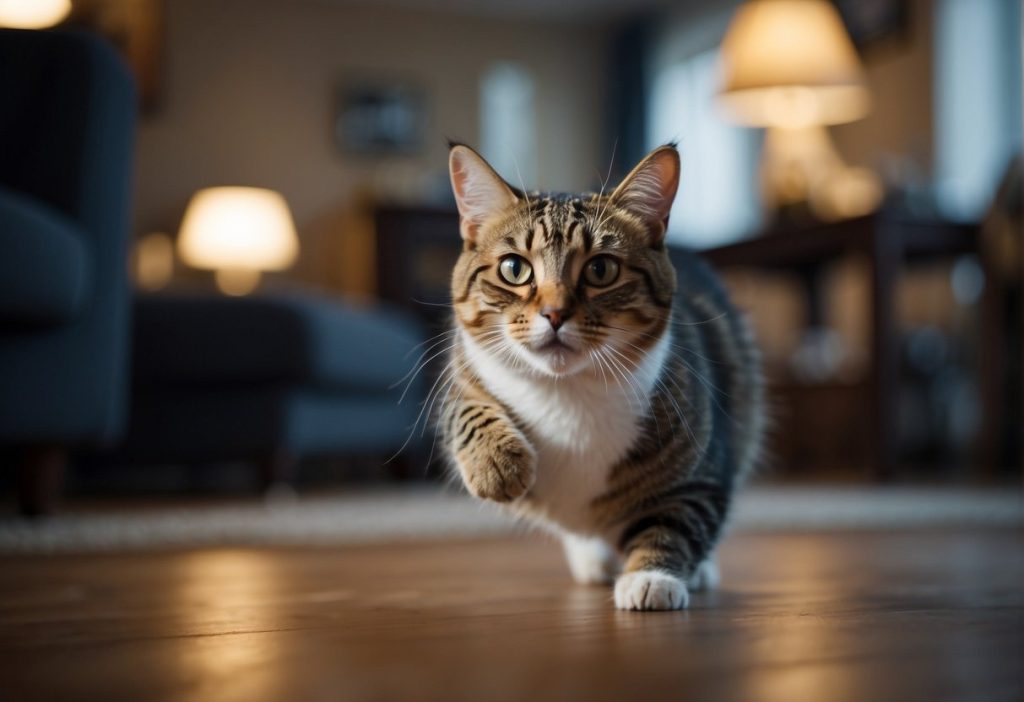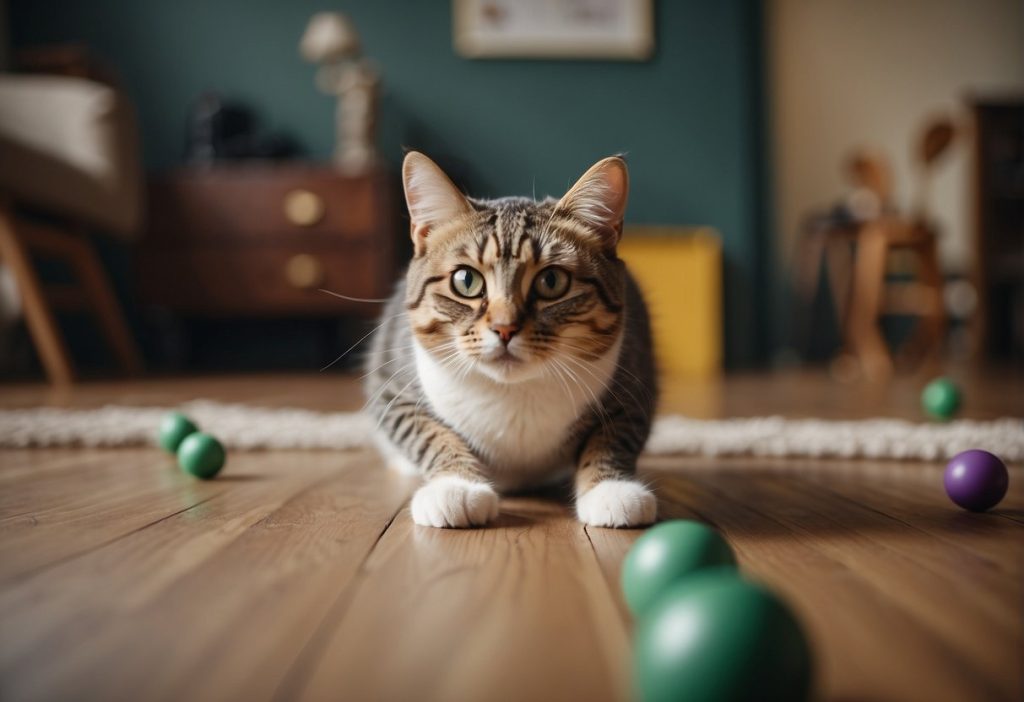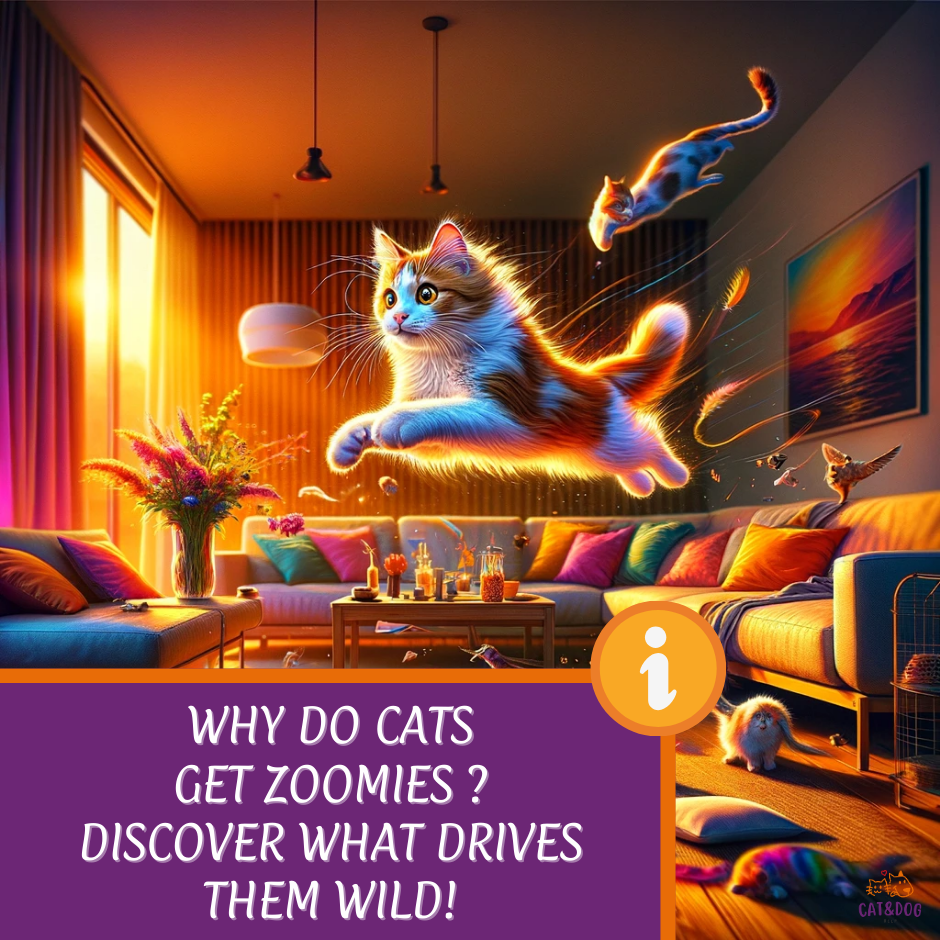Imagine you’re quietly reading in your favorite nook when suddenly your serene moment is disrupted by a blur of fur.
It’s your cat, racing through the living room at top speed, ricocheting off the furniture, and skidding around corners.
This amusing burst of energy, known as “cat zoomies,” often leaves cat owners both puzzled and entertained.
But have you ever found yourself wondering, “Why do cats get zoomies?”
These spontaneous sprints, where our feline friends exhibit an explosion of energy in a short period, often chasing after imaginary prey, are not just a quirky behavior. (1)
They have a scientific name too: Frenetic Random Activity Periods or FRAP for short.
This phenomenon is a fascinating glimpse into the world of feline psychology and physiology, revealing much about our pets’ needs and instincts. (2)

You might wonder why your cat transforms from a napping sweetheart to a speed demon without warning.
Zoomies are a normal and natural behavior for cats, providing an outlet for them to release pent-up energy and engage in playful behavior.
They are generally considered good because they satisfy their strong hunting instincts and allow them to hone their skills, just like they would in the wild.
While indoor cats may not have to chase down their dinner or sprint from danger, it’s important to ensure that the zoomies are not causing any harm or destruction due to excess energy.
This article aims to unravel the mysteries behind those adorable yet baffling cat zoomies.
We’ll delve into the triggers of these energetic episodes, understand their potential significance for your cat’s health, and discuss ways to manage this activity to keep your furry friend happy and healthy, even in the middle of the night.
Knowing when this behavior is normal or a sign of an underlying issue, especially in older cats, can also help you ensure your cat’s well-being
So, keep an eye out for any unusual patterns as we explore what lies beneath the zoomies.
Key Takeaways
- Cat zoomies are natural bursts of energy reflecting instinctual behavior.
- Understanding why zoomies occur helps in managing your cat’s physical and mental health.
- Recognizing abnormal zoomie patterns is important for identifying potential health issues.
Why Do Cats Get Zoomies?
Ever watched your feline friend suddenly race around the house like they’re on a secret mission? That’s what we call the ‘zoomies’ or scientifically—Frenetic Random Activity Periods (FRAPs).
You might wonder, “Why does Mittens turn into a tiny, furry racecar out of nowhere?”
The Science Behind Zoomies
Animals love a good sprint, including your cat! It’s part of their instinctual behavior, an echo of their predatory nature.
Cats are hardwired for short bursts of energy, essential for a wildcat’s hunt. Not to forget, these sprints are an excellent way for your whiskered companion to get some exercise and keep those reflexes sharp.
Understanding cat zoomies, especially in younger cats or kittens who are still learning how to hunt and play as ambush predators, and their natural predator instincts can help explain this common feline behavior.
Behavioral and Psychological Triggers
The zoomies also have a dash of brain chemistry. The central nervous system plays a DJ, with sensory stimuli hitting the play button for that Zoomie track.
It’s like your cat senses an invisible mouse and — whoosh — off they go!
Normal Cat Behavior
Don’t fret though! Over 70% of cats exhibit this behavior. Experts agree: that zoomies are fine. Like Dr. Fluffy Paws says, “It’s not craziness, it’s fitness!”
Health Implications of Zoomies
When to Worry Concern starts when you notice:
- A sudden zoomies habit in your senior cat
- Weird symptoms, like your fluffy friend losing weight or seeming down
- Running like they’ve sat on a thorn!
Watch out for changes in how often, how intense, or how long these mad dashes last.
Normal vs. Concerning Behavior
Let’s sort the okay-from-the-maybe-not:
- Post-litter box victory lap: normal.
- Non-stop sprints for no clear reason: time to call the vet.
By keeping an eye on Mittens’ zoomies, you ensure they stay amusing, not alarming.
So, next time you see your cat zipping around, you’ll understand they’re just being their usual, energetic selves. Just make sure the path is clear — safety first, zoomies second!
Expert Insights on Cat Zoomies
What Experts Say: Veterinarian Perspectives
Veterinarians explain that zoomies, or Feline Hyperthyroidism, could be a sign that your kitty is simply brimming with energy, especially after a long snooze. (3)
Did you know your cat can sleep up to 16 hours a day? Yep, they’re power nappers, but the only time they seem to be awake and ready to play is when you’re trying to get your beauty rest.
It’s time to find a solution with expert insights and veterinary advice.
However, not all zoomies are just fun and games.
Vets caution that if these bursts of energy seem excessive, they might point to an overactive thyroid, fleas, or other underlying health issues, especially in middle-aged and senior cats.
So, if you notice your companion channeling their inner Usain Bolt in rare cases, it’s worth chatting with your vet.
Behaviorist Insights: Understanding the Feline Mind
Animal behaviorists shed light on the psychological side of zoomies:
- Environmental Enrichment:
Cats need an environment that sparks their curiosity and mimics the wild. Think climbing, exploring, and hunting (even if it’s just a feather on a string). - Mental Stimulus:
Like solving a complex puzzle, indoor cats require activities that mentally challenge them, preventing the stir-crazies leading to zoomies.
Addressing Nighttime Zoomies: Strategies for a Peaceful Night
Late-night sprints? Here’s some advice to help manage those:
- Nighttime Routine: Establish a playtime right before bed to help tire out your feline friend.
- Safe Play Zone: Ensure your home is cat-friendly for nocturnal play without any risky obstacles.
Remember, zoomies are a normal part of cat behavior – they’re just channeling their inner lion!
But you’re wise to monitor for signs that could indicate a trip to the vet. Keep playtime fun, and both you and your feline will sleep better at night.
Beyond Play: Managing Cat Energy Levels

You’re living with a tiny predator that’s hardwired to hunt during these times. Aligning playtime with these natural rhythms can do wonders for their energy management.
Morning and Evening Sessions
Engage in playful activities with your kitty right after sunrise or just before sunset. These “hunting” hours will help them expend energy in a way that feels natural.
When the zoomies hit, it’s not just about physical exercise. It’s an emotional release too! A good chase or interactive game helps ensure emotional balance, keeping your cat content.
Ever noticed how a good play session seems to leave your cat more relaxed? It’s like yoga for them, but you know, with more pouncing!
Incorporating regular playtime, mental stimulation, and exercise into your cat’s routine is always a good idea, as it helps them stay happy, healthy, and entertained.
Providing mental stimulation for your cat can also help prevent or reduce the frequency of zoomies.
By keeping your cat’s mind engaged and active, they will be less likely to have bursts of energy and will be more content overall.
- Emotional Well-being 101:
- Case Study: Whiskers: After regular play, Whiskers showed a 30% decrease in anxious behavior.
- Case Study: Mittens: Consistent stimulation led to improved mood and fewer midnight zoomies.
- Case Study: Whiskers: After regular play, Whiskers showed a 30% decrease in anxious behavior.
Remember, a well-stimulated cat is a happy cat! It’s not just about burning off energy, it’s about fulfilling their predator instincts and keeping their mood purr-fect.
So here are a couple of tips on effectively managing those energy spikes:
- Stay Engaged: Use toys that mimic prey, like feather wands or laser pointers.
- Cool Down: After play, give them time to wind down, maybe with a treat or a gentle petting session.
Think of it as helping your kitty hit the ‘refresh’ button. With your support, they’ll have a healthy outlet for their zoomie tendencies and a chance for a well-rounded cat life!
Keep it consistent, and you may just find that playtime becomes the highlight of your day too!
Practical Tips for Cat Owners

Tailoring your cat’s environment to their instincts and needs is the key. Let’s break it down into simple steps.
Interactive Play and Exercise:
Have you ever seen your cat leap after a feather wand like they’re hunting in the wild? It’s not just cute, it’s crucial!
- Try These:
Grab a feather wand or a laser pointer, but remember – always supervise playtime and never shine lasers directly into your cat’s eyes. - Safety First:
After play, store these toys out of reach to prevent any unsupervised munching.
Environmental Enrichment:
Cats love to climb and explore. So, how about turning your home into a cat-friendly wonderland?
- Install cat trees and shelves to let your cat scale new heights.
- Consider puzzle feeders to challenge their brains and mimic the hunt for food.
Recognizing and Responding to Stress:
Are your cat’s zoomies a bit over the top? They could be stressed. Here’s how you can tell:
- Pacing, excessive meowing, or hiding more than usual? They might need your help.
- Create a comforting routine, and maybe even a dedicated ‘safe space’ for your cat.
To sum this up in a purr, playtime is prime time for your cat’s well-being, and a stimulating home is their playground. Keep an eye on their behavior, and you’ll be the best cat parent on the block!
When to Seek Professional Advice

Monitoring Your Cat’s Behavior
Let’s face it, your feline friend can be full of surprises, especially when they get the zoomies. Remember, it’s all about patterns and changes.
If you notice any of these changes, such as post-poop zoomies being a new behavior, or if you notice any abnormalities in their stool or urine, such as unusual color or consistency, it might be time to reach out to your cat’s veterinarian for professional advice.
- Sudden lethargy following typical zoomies (4)
- Aggression during or after the episode
- Persistent hiding or avoiding interaction post-zoomies
- Changes in appetite or elimination habits
- Excessive vocalization or restlessness (5)
Behavioral Changes to Watch For
Let’s list the reasons you might want to seek advice:
- Drastic changes in activity level
- Aggression that is new or escalating
- Unexplained, repetitive behaviors linked to zoomies (like over-grooming)
Professional Resources
“How do I sort the wheat from the chaff when looking for a pro?” Great question! Start with a visit to your veterinarian.
They know your cat and can rule out or treat medical conditions. If behavior is the sticking point, a certified animal behaviorist could be your next step.
- American Association of Feline Practitioners can help you find cat-friendly vets.
- The International Association of Animal Behavior Consultants is your go-to for accredited behavior experts.
Aim for professionals with solid reviews and relevant experience – it’s all about the right fit for you and your whiskered companion.
Quick Recap

Ever seen your cat suddenly sprint around the house as if they’re racing for the feline Olympics? That’s the zoomies for you—normal and quite a sight!
It’s simple:
- Energy spurts:
Cats are masters of the snooze but when they’re up, they’ve got energy to burn. - Nighttime hustle:
Ever noticed the zoomies often hit as you’re about to call it a night? Cats are crepuscular—meaning they’re naturally more active during dawn and dusk.
Here’s the gist:
- Playtime:
Whip out those toys! Interactive play is not just fun, it’s a great way to prevent a case of late-night zoomies. - Observation:
Notice something off during these sprints? Unusual behavior during zoomies might warrant a vet visit. - Enrichment:
Keep their environment engaging with cat trees, perches, and puzzles. Boredom can lead to a Zoomies outburst!
Just remember, your whiskered friend’s zoomies are a sign they’re healthy and spirited. They bring a unique energy to our homes that’s both entertaining and heartwarming.
Enjoy the show and embrace the joy your playful pal brings to your life!
Frequently Asked Questions
Let’s unravel the mystery behind your feline friend’s sudden sprints around the house. Read on to discover the quirks behind those endearing and sometimes puzzling cat zoomies.
What exactly are cat zoomies?
You know those frantic, full-speed, run-like-there’s-no-tomorrow moments your cat has? That’s the zoomies.
It’s when your cat suddenly dashes around with seemingly boundless energy, often after periods of rest.
Are Zoomies a sign my cat is happy?
Absolutely! Zoomies are often a sign of content and healthy cat letting off some steam and having a bit of fun. Think of it as their version of a happy dance.
Can zoomies indicate a health problem?
Rarely, but yes. If zoomies come with other changes in behavior, like a lack of appetite or aggression, it’s worth consulting your vet to rule out any underlying issues.
How can I safely manage my cat’s zoomies?
The key is to give them plenty of playtime and safe spaces to run around. Also, ensure all breakables are out of the way to avoid any kitty crash landings!
What are the best toys to prevent excessive zoomies?
Interactive toys like laser pointers, feather wands, and ball tracks can help your cat burn off energy. Plus, they’re great for bonding!
Why does my cat get zoomies at night?
Cats are naturally crepuscular, meaning they’re most active at dawn and dusk, so those late-night zoomies are just them following their instincts.
Keeping a routine play session before bed can help tire them out before your bedtime.
How do I differentiate between zoomies and stress-related behavior?
Zoomies are quick, joyous bursts of energy, while stress behaviors might include hiding, repeated licking, or excessive meowing.
Knowing your cat’s normal behavior is key to spotting the difference.


